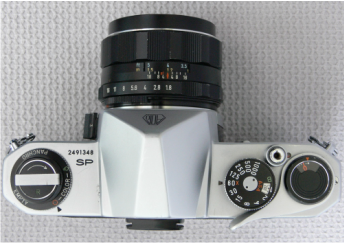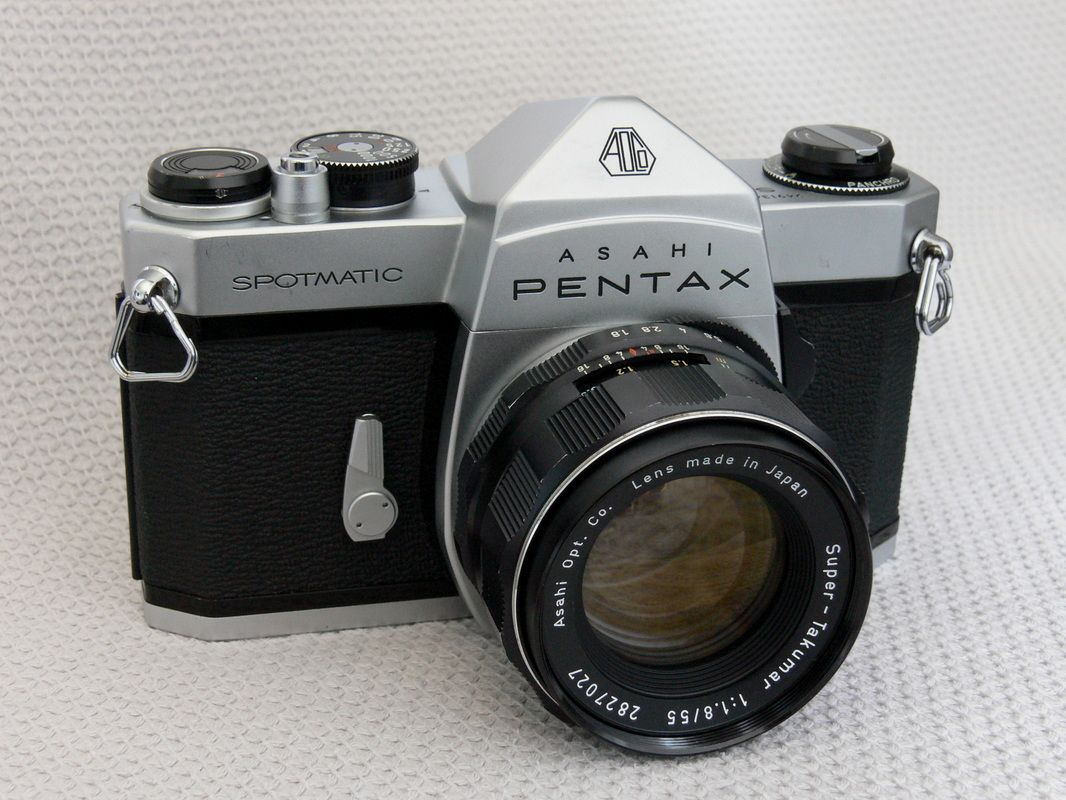|
Updated Apr. 27, 2022 Domination of the mid-to-late 1960's sales charts. Millions of devoted fans. As influential on SLR development as a certain group of four blokes were on rock 'n' roll during the same period. We can only be talking about one camera...the Pentax Spotmatic (or Spottie to its ardent admirers), the first true superstar SLR. Genesis September 1960. Germany. While a five-man band just freshly minted as the Beatles are honing their craft in the clubs of Hamburg, over 400 km (250 miles) away in Cologne, at the Photokina tradeshow, the Asahi Optical Company is creating a buzz of its own. They have just unveiled a prototype SLR featuring a built-in TTL (through-the-lens) spotmeter. Appropriately designated SPOT-MATIC (note the hyphen), the camera also features a 1/2000 sec. top speed shutter and a bayonet lens mount (15 years before the K-mount debuted in 1975!). The meter consists of a CdS (cadmium sulfide) cell that swings into the light path at the press of a button to take a light reading and then swings out of the way prior to exposure. This reading is shown by means of a center-the-needle display in the viewfinder. A Shooting Star Fast forward four years and the SPOTMATIC finally reaches production, and the Beatles finally reach America. But there have been a few changes. The Beatles now consist of four members (with only three of them dating from their 1960 debut in Hamburg) and sporting quite a different look. Very late in development, Pentax decides that a spot meter may be a little advanced for their target audience...so, they make the change to an averaging meter that they believe will be easier for the amateur photographer to use. But the marketing materials have already been prepared and the dies cast for the nameplates. Plus, Spotmatic still sounds better than Average-o-matic or Meter-matic ;-). Along with the hyphen, the production camera loses the 1/2000 sec. shutter speed and the bayonet mount is dropped in favor of the existing M42 screwmount. The swinging metering cell has also been replaced by two fixed cells located beside the finder eyepiece under the top plate. The Spottie is an unparalleled success! It is the single best-selling SLR from any camera company every year from 1965 to 1970. Annual Spotmatic production alone is greater than the total combined SLR production of Canon and Nikon from 1966 to 1969. Over 3.6 million Spotmatics of all ilks are eventually made. Can you say SOOPAH-STAH?!! Oh, and the Beatles merely have 20 Billboard number 1 hits and sell only 28.5 million albums in the US during the same time period.  The Spotmatic is not the first SLR to feature TTL metering, nor does it necessarily have the best integration of TTL metering. Both the Topcon RE Super (1962) and Alpa 9d (1963) beat the Pentax to market. Nevertheless, it is the Spotmatic that captures the hearts of photographers. What does it have that the others don't? Most importantly, it's relatively affordable. The other two cameras are much more expensive...like Nikon F-and-higher-expensive. Also, it has a familiar look and control layout. The Spottie is really only the latest in a line of Pentax models (that members of the Beatles already are using, by the way) that have reached a very high level of refinement. The controls are simple and move with precision. You just feel a certain something when you hold it in your hand, the milled film advance lever wonderfully smooth and positive in its action, and that responsive shutter release. Pure mechanical poetry. The Super Takumar line of lenses are already very popular and are completely compatible with this new model. And the new metering system is very easy to understand and use. It's the right camera, at the right time, at the right price. And it will take its rightful place in the Pentax pantheon, spawning at least six more Pentax M42 screwmount models and and serving as the genetic basis for the K-series SLRs (including the prototypical student-camera, the K1000, which will be produced into the late-'90s). As a side note: Pentax made motor drive versions of various Spotmatic models in very limited quantities; they were special order items, and command high prices as such. The Spotmatic Family Tree Mechanical Models 1964 - SPOTMATIC aka SP
1971 - SPOTMATIC II/IIa aka SPII
1971 - SP500
1973 - SPOTMATIC F
1973 - SP1000
Electronic Models 1971 - ELECTRO SPOTMATIC/ES
1973 - ESII
The Star Begins to Fade Pentax initially could not keep up with the demand for the Spotmatic. And this was where they began to pay a price for their success. The other major Japanese manufacturers were quick to jump on the TTL bandwagon with the Nikkormat FT (1965), Minolta SRT-101 (1966), and Canon FT (1966). While the Canon emulated the stop-down metering procedure of the Spotmatic (meaning that the aperture must be stopped-down and the viewfinder darkened to get the proper reading, then opened back up so focusing can be done at full aperture with a bright viewfinder), the Nikon and Minolta models featured full-aperture TTL metering (meaning metering takes place at wide-open aperture, with camera automatically compensating to get the proper reading; which eliminates the extra stop-down procedure). In trying to catch Pentax, the other camera makers were forced to innovate and improve their own SLRs. With Pentax selling SPs as fast as they could make them, stopping production, even momentarily, to introduce major improvements was too tough a pill to swallow. That Pentax was capable of innovation was not in doubt; their prototypes reflected that they clearly saw where SLR development needed to go. The Metalica II prototype of 1966 featured an electronically-controlled, vertical-travel shutter, aperture priority auto exposure, and, again, a bayonet lens mount. Due to the Spotmatic's continued popularity, however, they delayed the introduction of full-aperture metering until the Electro Spotmatic of 1971 & Spotmatic F of 1973 and the K-mount bayonet did not appear until 1975. Such hesitation would lead to a long and winding road of sales decline from 1969 until the debut of the K-series SLRs. Annual Spotmatic production peaked in 1968 at approximately 500,000 units. From then on, things would only go downhill as far as Pentax' domination of the market was concerned. Why? Let's consider a couple of reasons:
Just how important was a bayonet mount? Well, in 1974, the last year of the all-Spotmatic M42-mount lineup, sales were just over 300,000. In 1975, a year of overlap between M42 and the new K-mount, Spotmatic sales dropped by about 20,000, but sales of the 3 new K-models totaled 300,000. And half of those K-mount sales were of the KM model, which was basically a Spotmatic F with a bayonet mount. It makes one wonder if Pentax could have avoided a large portion of its seven-year sales decline from 1968-74 by introducing a bayonet mount earlier. Conclusion Spotmatic. It defines the classic paradigm of the mechanical SLR: simplicity and precision construction. It changed the way SLRs were used; you could keep the camera to your eye while metering, no longer looking back and forth between it and a handheld meter. It spurred its competitors to greater efforts, and so played a pivotal role in the evolution of the SLR. Definitely superstar material. Even the Fab Four would surely approve :-). References: Pentax: 1964 -1976: The Spotmatic @ http://www.pentax-slr.com/71760549 Asahi Pentax Spotmatic - 1964 @ http://basepath.com/Photography/Spotmatic.php Pentax Spotmatic, Spotmatic II, Spotmatic F User Manuals @ www.butkus.org Pentax ES & ESII User Manuals @ www.butkus.org The Definitive Asahi Pentax Collector's Guide 1952-1977 by Gerjan van Oosten
10 Comments
C.J. Odenbach
6/11/2017 11:06:40 pm
Thank you for taking the time to comment and for the kind words JR. I love me some Spotties, too. Happy shooting :-)
Reply
Alex Staruszkiewicz
6/19/2017 04:20:55 pm
great story, Nicely told
Reply
C.J. Odenbach
6/19/2017 05:25:11 pm
Thanks, Alex. I'm glad you enjoyed it.
Reply
Gerjan van Oosten
3/30/2022 10:40:56 am
Interesting story.
Reply
C.J. Odenbach
3/30/2022 12:51:49 pm
Thanks so much for reaching out, Mr. van Oosten. I have ordered a copy.
Reply
JEFF H
4/18/2022 08:04:42 pm
My father bought his SP in 1965, used it for almost 20 yrs; replacing it with Canon AE-1 Program. I got the SP in '84 when I was in high school as the hand-me-down-er; my very first SLR (Ricoh 35 zf was my first camera). Today, the super-Takumar 55mm is almost permanently mounted on my GX85, and it's one of my favorite manual focus lens.
Reply
C.J. Odenbach
4/19/2022 08:15:32 am
That's a great story, Jeff. I would say you did very well with the SP for a first SLR. I would take one over a K1000 any day ;-). I love that you're still getting plenty of mileage out of that Super-Tak 55, too. Personally, the 55mm Pentax lenses are my favorites out of the entire line. Best regards.
Reply
C.J. Odenbach
7/14/2022 07:59:42 am
You're welcome. Glad to see that you enjoyed it :-).
Reply
Your comment will be posted after it is approved.
Leave a Reply. |
C.J. OdenbachSuffers from a quarter-century and counting film and manual focus SLR addiction. Has recently expanded into 1980's AF point and shoots, and (gack!) '90s SLRs. He even mixes in some digital. Definitely a sick man. Categories
All
Archives
June 2024
|

 RSS Feed
RSS Feed